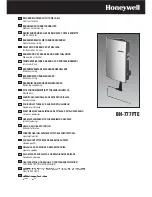
-12-
-13-
8. MEASURING ACTIVE CHLORINE
CONCENTRATION WITH WATATEST
®
It is essential to test the quality of the sodium hypochlorite solution produced
in order to determine the dosage to apply depending on its use.
The WataTest
®
reagent allows to perform this control easily and quickly.
Please refer to the WataTest® user’s manual.
9. USING A SODIUM HYPOCHLORITE
SOLUTION TO CHLORINATE
DRINKING WATER
W
It is important to chlorinate only water of sufficient quality, i.e. with a turbidity
of less than 5 units, and a pH between 6.5 and 8.5 (see section 4). If the water is
muddy, cloudy or coloured, it is crucial to filter or clarify it beforehand.
The dose of active chlorine to add to the water so as to make it drinkable depends on
how contaminated the water is initially. To ensure that 99% of pathogenic organisms are
destroyed 30 minutes after chlorination, it is sufficient to check whether any residual chlorine
remains in the water. For this purpose, we propose a pragmatic method that is ideal for visual
checking using the WataBlue
®
reagent to determine whether a sufficient quantity of residual
chlorine remains in the water.
To guide you for the first dosage, we recommend a dose of 1.5 mg/L of sodium hypochlorite.
At this dose, 1 litre of sodium hypochlorite at a 6 g/L concentration produced by the WATA
®
device can be used to treat approximately 4,000 litres of water, if the initial water quality is
compliant with the above-mentioned turbidity and pH criteria.
W
Drinking water must contain between 0.5 et 1 mg/L of free residual chlorine.
W
The treated water must be stored in a clean, opaque, closed tank.
W
Chlorination must be performed under the supervision of a qualified person.
WataTest®
50ml
E
x
p
ir
e on/
le
: XX
.Y
Y.
Z
Z
S
e
rial
/
L
o
t n
o
: XX
.XX
.Y
Y
-X
CONTROL REAGENT
FOR AVAILABLE CHLORINE
RÉACTIF DE CONTRÔLE
DU CHLORE ACTIF DE
SOLUTION DE CHLORE
ANTENNA.CH
6.4 WATA-PLUS
®
MAINTENANCE
After each use, rinse the WATA-Plus
®
with clean water. With time, white deposits (limestone)
might appear on the electrodes. To clean them, prepare a solution of 50% vinegar and 50%
clean water. Use a bucket of about 10 litres and prepare approximately 6 litres of a solution
composed of 3 litres of vinegar and 3 litres of water. The titanium plates must be completely
immersed in the solution. Let the device soak in the vinegar solution for at least 24 hours and
then visually inspect the condition of the device (the limestone deposits have disappeared).
Rinse with clean water. Never rub the titanium plates.
7. STORAGE AND STABILISATION
7.1 STORAGE
Store the sodium hypochlorite solution in a clean,
tightly-closed, opaque, non-metallic container, and
label it with the production date. Place the container
in a cool place, out of the reach of children. Do not
expose to sunlight.
W
Sodium hypochlorite can keep for 24 hours
without any need for testing. After that time
has elapsed, measure the concentration
with the WataTest
®
and adapt the dilutions
accordingly.
7.2 STABILISING THE CHLORINE SOLUTION
W
To use a sodium hypochlorite solution produced by the Maxi-WATA
®
electrical
chlorinator device after more than 24 hours, we propose a stabilisation method
using caustic soda (NaOH).
This new process requires the use of a pH meter or pH testing strips. Laboratory skills and
equipment are also required, but the process ensures a six-month minimum storage life.
Information about this procedure is available at www.antenna.ch
W
If you would like to produce sodium hypochlorite for the purposes of distributing it
in vials, stabilisation will be required. You must comply with legislation effective in
the country where you operate. A quality control procedure validated by the local
authorities must be implemented.





























